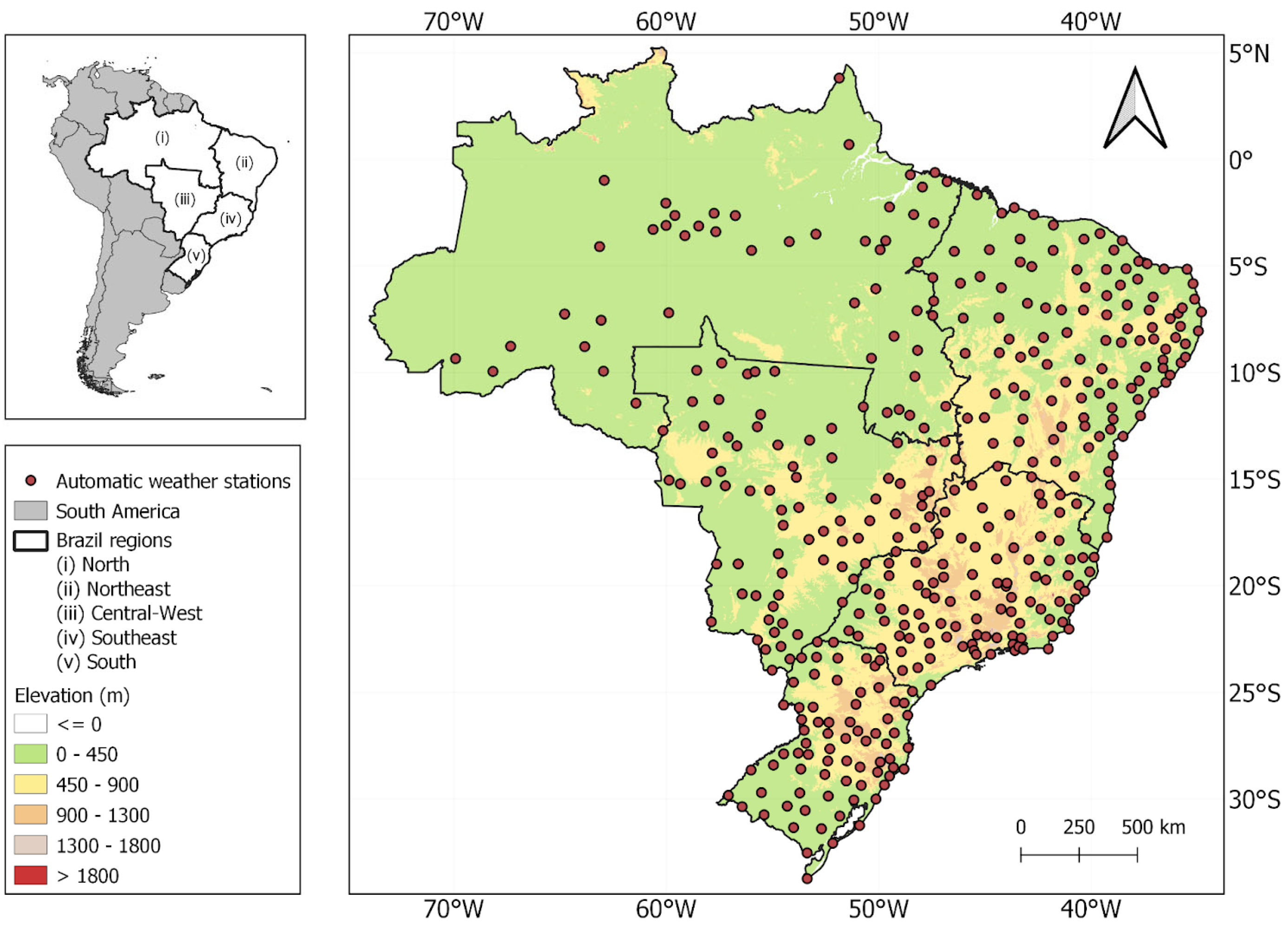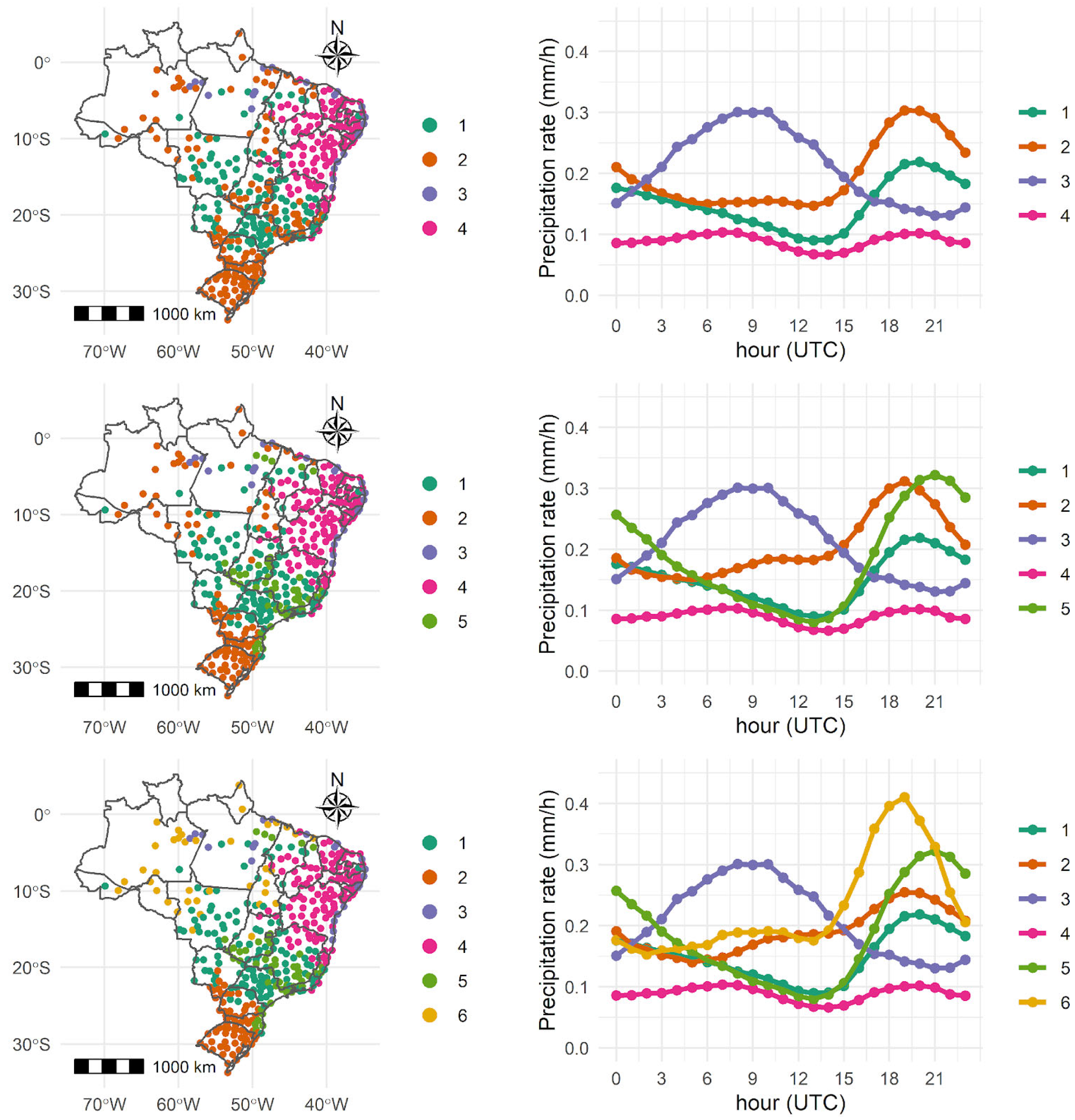Analyses of Maximum Precipitation in Brazil and the Variability of Diurnal Cycle †
Abstract
:1. Introduction
2. Materials and Methods
2.1. Database
2.2. Clustering Method
3. Results
4. Conclusions
Author Contributions
Funding
Institutional Review Board Statement
Informed Consent Statement
Data Availability Statement
Conflicts of Interest
References
- Meredith, E.P.; Ulbrich, U.; Rust, H.W. The diurnal nature of future extreme precipitation intensification. Geophys. Res. Lett. 2019, 46, 7680–7689. [Google Scholar] [CrossRef]
- Lewis, H.W.; Sanchez, J.M.C.; Arnold, A.; Fallmann, J.; Saulter, A.; Graham, J.; Bush, M.; Siddorn, J.; Palmer, T.; Lock, A.; et al. The UKC3 regional coupled environmental prediction system. Geosci. Model Dev. 2019, 12, 2357–2400. [Google Scholar] [CrossRef]
- Webster, P.J.; Clayson, C.A.; Curry, J.A. Clouds, Radiation, and the Diurnal Cycle of Sea Surface Temperature in the Tropical Western Pacific. J. Clim. 1996, 8, 1712–1730. [Google Scholar] [CrossRef]
- Yan, B.; Chan, P.W.; Li, Q.; He, Y.; Shu, Z. Dynamic analysis of meteorological time series in Hong Kong: A nonlinear perspective. Int. J. Climatol. 2021, 41, 4920–4932. [Google Scholar] [CrossRef]
- Boccippio, D.J.; Koshak, W.J.; Blakeslee, R.J. Performance Assessment of the Optical Transient Detector and Lightning Imaging Sensor. Part I: Predicted Diurnal Variability. J. Atmos. Ocean. Technol. 2002, 9, 1318–1332. [Google Scholar] [CrossRef]
- Minobe, S.; Park, J.H.; Virts, K.S. Diurnal cycles of precipitation and lightning in the tropics observed by TRMM3G68, GSMaP, LIS, and WWLLN. J. Clim. 2020, 33, 4293–4313. [Google Scholar] [CrossRef]
- Backman, J.; Rizzo, L.V.; Hakala, J.; Nieminen, T.; Manninen, H.E.; Morais, F.; Aalto, P.P.; Siivola, E.; Carbone, S.; Hillamo, R.; et al. On the diurnal cycle of urban aerosols, black carbon and the occurrence of new particle formation events in springtime São Paulo, Brazil. Atmos. Chem. Phys. 2012, 12, 11733–11751. [Google Scholar] [CrossRef]
- Wimmer, W.; Mazon, S.B.; Manninen, H.E.; Kangasluoma, J.; Franchin, A.; Nieminen, T.; Backman, J.; Wang, J.; Kuang, C.; Krejci, R.; et al. Ground-based observation of clusters and nucleation-mode particles in the Amazon. Atmos. Chem. Phys. 2018, 18, 13245–13264. [Google Scholar] [CrossRef]
- da Rocha, R.P.; Morales, C.A.; Cuadra, S.V.; Ambrizzi, T. Precipitation diurnal cycle and summer climatology assessment over South America: An evaluation of Regional Climate Model version 3 simulations. J. Geophys. Res. 2009, 114, D10108. [Google Scholar] [CrossRef]
- Santos e Silva, C.M.; Lúcio, P.S.; Spyrides, M.H.C. Distribuição espacial da precipitação sobre o Rio Grande do Norte: Estimativas via satélites e medidas por pluviômetros. Rev. Bras. Meteorol. 2012, 27, 337–346. [Google Scholar] [CrossRef]
- Johnson, G.L.; Daly, C.; Taylor, G.H.; Hanson, C.L. Spatial variability and interpolation of stochastic weather simulation model parameters. J. Appl. Meteorol. Climatol. 2000, 39, 778–796. [Google Scholar] [CrossRef]
- Reboita, M.S.; Dutra, L.M.M.; Dias, C.G. Diurnal cycle of precipitation simulated by RegCM4 over South America: Present and future scenarios. Clim. Res. 2016, 70, 39–55. [Google Scholar] [CrossRef]
- Watters, D.; Battaglia, A.; Allan, R.P. The diurnal cycle of precipitation according to multiple decades of global satellite observations, three CMIP6 models, and the ECMWF reanalysis. J. Clim. 2021, 34, 5063–5080. [Google Scholar] [CrossRef]
- Hair, J.F.; Black, W.C.; Babin, B.J.; Anderson, R.E.; Tatham, R.L. Análise Multivariada de Dados, 5th ed.; Adonai, T., Sant’Anna, S., Anselmo, C.N., Eds.; Bookman: Porto Alegre, Brazil, 2006; pp. 425–478. [Google Scholar]
- Mingoti, S.A. Análise de Dados Através de Métodos de Estatística—Multivariada—Uma Abordagem Aplicada; UFMG: Belo Horizonte, Brazil, 2005. [Google Scholar]
- Mimmack, G.M.; Mason, S.J.; Galpin, J.S. Choice of Distance Matrices in Cluster Analysis: Defining Regions. J. Clim. 2001, 14, 2790–2797. [Google Scholar] [CrossRef]
- Oliveira, P.T.; Silva, S.; Lima, K.C. Climatology and trend analysis of extreme precipitation in subregions of Northeast Brazil. Theor. Appl. Climatol. 2017, 130, 77–90. [Google Scholar] [CrossRef]
- de Abreu, L.P.; Mutti, P.R.; Lima, K.C. Variabilidade espacial e temporal da precipitação na bacia hidrográfica do Rio Parnaíba, Nordeste do Brasil. Rev. Bras. Meio Ambiente 2019, 7, 3524759. [Google Scholar] [CrossRef]
- Ward, J.H. Hierarchical Grouping to Optimize an Objective Function. J. Am. Stat. Assoc. 1963, 58, 236–244. [Google Scholar] [CrossRef]
- Hervada-Sala, C.; Jarauta-Bragulat, E. A program to perform Ward’s clustering method on several regionalized variables. Comput. Geosci. 2004, 30, 881–886. [Google Scholar] [CrossRef]


Disclaimer/Publisher’s Note: The statements, opinions and data contained in all publications are solely those of the individual author(s) and contributor(s) and not of MDPI and/or the editor(s). MDPI and/or the editor(s) disclaim responsibility for any injury to people or property resulting from any ideas, methods, instructions or products referred to in the content. |
© 2023 by the authors. Licensee MDPI, Basel, Switzerland. This article is an open access article distributed under the terms and conditions of the Creative Commons Attribution (CC BY) license (https://creativecommons.org/licenses/by/4.0/).
Share and Cite
Valentim, A.M.; Santos e Silva, C.M.; Rodrigues, D.T.; de Araújo, P.A.A. Analyses of Maximum Precipitation in Brazil and the Variability of Diurnal Cycle. Environ. Sci. Proc. 2023, 25, 95. https://doi.org/10.3390/ECWS-7-14229
Valentim AM, Santos e Silva CM, Rodrigues DT, de Araújo PAA. Analyses of Maximum Precipitation in Brazil and the Variability of Diurnal Cycle. Environmental Sciences Proceedings. 2023; 25(1):95. https://doi.org/10.3390/ECWS-7-14229
Chicago/Turabian StyleValentim, Aléxia Monteiro, Cláudio Moisés Santos e Silva, Daniele Tôrres Rodrigues, and Paula Andressa Alves de Araújo. 2023. "Analyses of Maximum Precipitation in Brazil and the Variability of Diurnal Cycle" Environmental Sciences Proceedings 25, no. 1: 95. https://doi.org/10.3390/ECWS-7-14229
APA StyleValentim, A. M., Santos e Silva, C. M., Rodrigues, D. T., & de Araújo, P. A. A. (2023). Analyses of Maximum Precipitation in Brazil and the Variability of Diurnal Cycle. Environmental Sciences Proceedings, 25(1), 95. https://doi.org/10.3390/ECWS-7-14229







